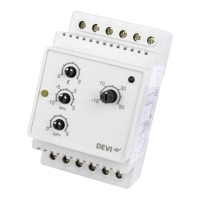32
B: How it works
Roof system
The roof system is fully automated.
It gathers information on moisture
and temperature via digital sen-
sors continuously. The sensors are
placed on strategic spots in gutters
or down pipes (for further informa-
tion on the sensor please refer to
the sensor manual). By combining
measurements of both moisture
and temperature a reliable detection of the situation is achieved. Hence it is known
whether heating of the roof area is needed in order to avoid that the roof is covered by
ice and snow.
Standby
The system is on standby and awaits heating of the roof area. Heating of the roof area
will start when the following conditions are fullled:
t.FBTVSFENPJTUVSFJTIJHIFSUIBOUIFDIPTFOMJNJUGPSNPJTUVSF
t.FBTVSFEUFNQFSBUVSFJTMPXFSUIBOUIFDIPTFONFMUJOHUFNQFSBUVSF
Temperature and moisture are measured continuously by the sensors.
Melting ice and snow
The roof area is heated in periods of 3 hours. Within that period a decrease in mois-
ture will stop the heating and activate post-heating. The post-heating function can be
disabled.
Measuring temperature
The heating function is suspended every third hour meaning that the heating cables
are turned o. This is done in order to allow the sensors to measure the temperature,
without being inuenced by the heated cables. The temperature measurement may
last up to 20 minutes. If the measured temperature is higher than the chosen melting
temperature the heating period is ended; if not, heating of the roof area is resumed
after the temperature measurement.
Post-heating
If the reason for ending a heating period is a decrease of moisture to below the chosen
level the post-heating period will start. Post-heating ensures that no ice and snow is
left on the roof.
Appendix B
Standby
(No heating)
Melting
(Heating)
Post-heating
(Heating)
Measuring
temperature
(No heating)
Temperature < Melting temperature
and
Moisture > Moisture limit
Moisture < Moisture limit
After 3 hours
0-20 minutes
Post-heating time elapsed
Temperature >
Melting temperature

